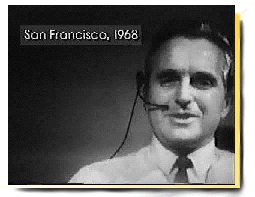|
|
 WELCOME
to the
MouseSite, a resource for exploring the history of human computer
interaction beginning with the pioneering work of Douglas Engelbart
and his colleagues at Stanford Research Institute in the 1960s.
WELCOME
to the
MouseSite, a resource for exploring the history of human computer
interaction beginning with the pioneering work of Douglas Engelbart
and his colleagues at Stanford Research Institute in the 1960s.
As a graduate student in electrical engineering at UC Berkeley
after World War II Doug Engelbart began to imagine ways in which
all sorts of information could be displayed on the screens of
cathode ray tubes like the ones he had used as a radar technician
during the war, and he dreamed of "flying" through
a variety of information spaces.
For two years beginning in 1959 at SRI in Menlo Park, Engelbart
was provided the opportunity to pursue his visionary ideas further
into the formulation of a theoretical framework for the co-evolution
of human skills, knowledge, and organizations. At the heart of
this vision was the computer as an extension of human communication
capabilities and resource for the augmentation of human intellect.
By 1968 Engelbart and a group of young computer scientists and
electrical engineers he assembled in the Augmentation Research
Center at SRI were able to stage a 90-minute public multimedia
demonstration of a networked computer system. This was the world
debut of the computer mouse, 2-dimensional display editing, hypermedia--including
in-file object addressing and linking, multiple windows with
flexible view control, and on-screen video teleconferencing.

|

